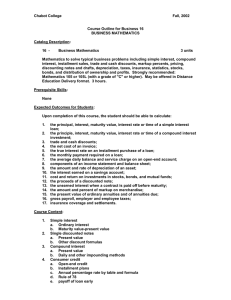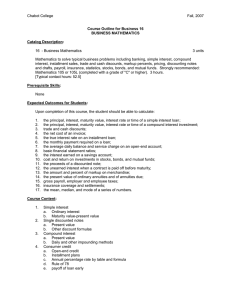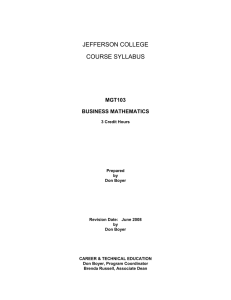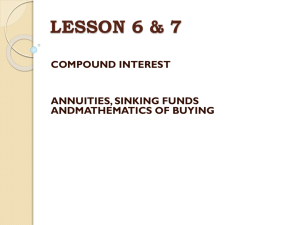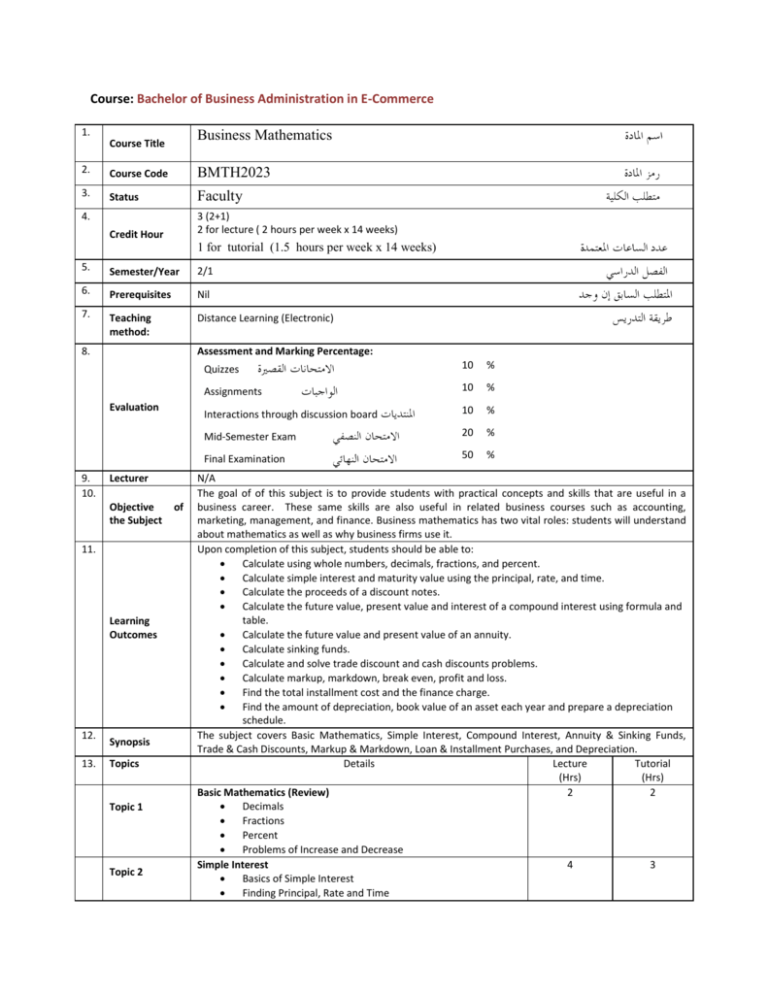
Course: Bachelor of Business Administration in E-Commerce
1.
Business Mathematics
Course Title
2.
Course Code
BMTH2023
3.
Status
Faculty
Credit Hour
3 (2+1)
2 for lecture ( 2 hours per week x 14 weeks)
4.
1 for tutorial (1.5 hours per week x 14 weeks)
5.
Semester/Year
2/1
6.
Prerequisites
Nil
7.
Teaching
method:
Distance Learning (Electronic)
8.
Assessment and Marking Percentage:
Evaluation
9.
10.
Lecturer
Objective
the Subject
11.
Learning
Outcomes
12.
13.
Synopsis
Topics
Topic 1
Topic 2
of
Quizzes
10
%
Assignments
10
%
Interactions through discussion board
10
%
Mid-Semester Exam
20
%
Final Examination
50
%
N/A
The goal of of this subject is to provide students with practical concepts and skills that are useful in a
business career. These same skills are also useful in related business courses such as accounting,
marketing, management, and finance. Business mathematics has two vital roles: students will understand
about mathematics as well as why business firms use it.
Upon completion of this subject, students should be able to:
Calculate using whole numbers, decimals, fractions, and percent.
Calculate simple interest and maturity value using the principal, rate, and time.
Calculate the proceeds of a discount notes.
Calculate the future value, present value and interest of a compound interest using formula and
table.
Calculate the future value and present value of an annuity.
Calculate sinking funds.
Calculate and solve trade discount and cash discounts problems.
Calculate markup, markdown, break even, profit and loss.
Find the total installment cost and the finance charge.
Find the amount of depreciation, book value of an asset each year and prepare a depreciation
schedule.
The subject covers Basic Mathematics, Simple Interest, Compound Interest, Annuity & Sinking Funds,
Trade & Cash Discounts, Markup & Markdown, Loan & Installment Purchases, and Depreciation.
Details
Lecture
Tutorial
(Hrs)
(Hrs)
Basic Mathematics (Review)
2
2
Decimals
Fractions
Percent
Problems of Increase and Decrease
Simple Interest
4
3
Basics of Simple Interest
Finding Principal, Rate and Time
Topic 3
Topic 4
Exact and Ordinary Interest
Promissory notes
Simple Discount Notes
Discounting a Note Before Maturity
Compound Interest
Compound Interest
Present Value of a compound amount
Annuity
Annuities and retirement account
Present Value of an annuity
Sinking Funds (Finding annuity payments)
4
2
4
3
Topic 5
Topic 6
Topic 7
Topic 8
14.
Main
references:
15.
Additional
References:
Other
Materials:
Mathematics of buying
4
3
Invoices and Trade Discounts
Single Discount Equivalents
Cash Discount : Ordinary Dating Method
Cash Discounts : Other Dating Methods
Mathematics of Selling
4
3
Markup on Cost
Markup on Selling Price
Markdown
Breakeven, Profit and Loss
Consumer Loans
2
2
Open-End Credit and Charge Cards
Installment Loan
Depreciation
4
3
Introduction to Depreciation
Straight Line Method
Double Declining Balance Method
Sum-of-Years’ Digits Method
Units of Production Method
Total contact hours
28
21
Equivalent lecture hours
28
14
Total lecture hours
42
Credit hours
3
1.
Miller, Charles D., Saltzman, Standly A. and Glendenen, Gary (2006). Business Mathematics (10th
ed.) Pearson Addison Wesley.
2.
Bluman, Allan G. (2006). Business Math Demystified. McGraw-Hill Professional.
1.
Hubbard, Douglas W (2007). Finding the Value of “Intangibles” in Business”.
2.
W. Roueche, Nelda, R., Graves, Virginia and Tuttle, Micheal D. (2005). Business Mathematics (9th
ed). Prentice Hall.
3.
Lau, Too Kya, Phang, Yook Ngor and Wee, Kok Kiang (2007). Business Mathematics for UiTM (2nd
ed.) OxfordFajar.
4.
Stutely, Richard (2003). The Essentials of Business Numeracy (5th ed). Bloombery Press.
All other materials will be available to students online.





